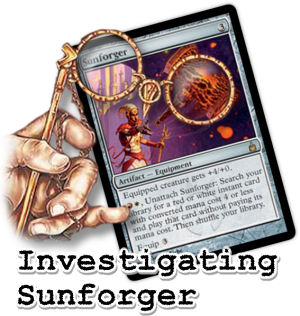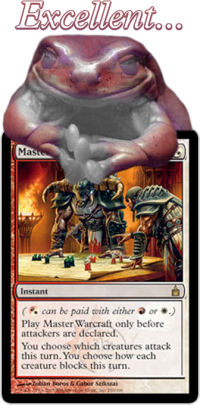
While working on the Ravnica Constructed Review articles, one of the new cards that really stood out to me was Sunforger. Sunforger costs three mana to play and three mana to equip, giving its bearer +4/+0. In and of itself, this repertoire would make Sunforger almost strictly worse than Loxodon Warhammer, a card long on potential itself, but one that has been completely absent from Constructed deck for the past two years and change; however, the neat thing on about Sunforger is that if you pay R/W, you can unattach it to search through your library for a Red or White instant that costs four or fewer mana and play it immediately. On a lark, I actually posted a potential Sunforger deck in the Ravnica Artifacts section… but later realized it might actually be good.
From a deck construction standpoint, Sunforger enforces several design constraints. You have to play instants, they have to be Red or White, and they have to cost a certain amount of mana. In a sense, this card operates similarly to Survival of the Fittest. The targeting is a bit stricter on Sunforger, but the upsides are also better. Rather than having to discard a card, you only have to spend mana; though the amount of mana you are paying is not inconsiderable, you don’t have to actually pay for the spell in question. That’s why I decided to play Seed Spark, a card I gave a “Role Player” rating but didn’t like overmuch in the initial set review. Additionally, Mark Young pointed out that Master Warcraft goes straight into this kind of a deck, and I completely missed that on my initial pass. [I got smashed by the latter combo in a draft recently. What a beating. – Knut] This is what I tested last night:
4
“>Sensei’s Divining Top
1
“>Sunforger
1
“>Tatsumasa, the Dragon Fang
4 Umezawa’s Jitte
4
“>Lightning Helix
4
“>Loxodon Hierarch
1
“>Master Warcraft
4
“>Watchwolf
4
“>Civic Wayfarer
4
“>Sakura-Tribe Elder
1
“>Char
4
“>Godo, Bandit Warlord
1 Seed Spark
5 Forest
1 Mountain
3 Plains
4
“>Sacred Foundry
4
“>Temple Garden
4
“>Tendo Ice Bridge
2 Vitu-Ghazi, the City-Tree
Now this deck is supposed to be investigating Sunforger… So why do I only have one Sunforger? The answer is that with Godo, Bandit Warlord, you can get Sunforger without playing a lot of copies. Sunforger itself wants to be played in a deck full of instants, not redundant equipment. In any case, Sunforger is both mana intensive and requires you to have creatures in play; therefore drawing multiple copies isn’t very good.
Sensei’s Divining Top has become a staple in any Green deck with any kind of shuffling, and this one has not only Sakura-Tribe Elder, but Civic Wayfinder, Godo, and Sunforger itself constantly shuffling the deck. I have been playing a lot of Civic Wayfinders in my new decks in the “Kodama’s Reach spot” because Kodama’s Reach is terrible on the draw against an aggressive deck and Civic Wayfinder can carry a Jitte.
As for Sunforger instants, I decided to run 4 Lightning Helix, 1 Char, 1 Master Warcraft, and 1 Seed Spark. Lightning Helix is too good not to play, and as with last week’s article, I think Hypnotic Specter control is the most important thing to keep in mind in the new format. The single Char is also a potential Hypno killer, but is there to take out a certain pesky 2/4 that can single-handedly dominate games. I would have liked some Yamabushi’s Flames as well, but the slots in this deck are already difficult to cut. Yamabushi’s Flame helps out against things like Yosei, the Morning Star; that big Dragon was a thorn in this deck’s side for much of the testing.
The first deck I tested against was Sean McKeown U/G/W listing reminiscent of the TOGIT deck from PT: Philadelphia. That deck and this one have a lot in common, including similar draw/selection engines and the same long game. However Sean’s deck has four copies of Vitu-Ghazi, the City-Tree and four copies of Wrath of God starting, so I thought that his deck would have some advantages. As it turned out, the U/G/W pairing is an easy one for Investigating Sunforger, with the Godo deck coming out on top, 7-3.
Sean’s deck generally came out on top via Yosei, the Morning Star. Remember what I said about Yamabushi’s Flame? One game I was sad that I had cut Reciprocate for Master Warcraft because I took a 5 point Dragon to the nug and then saw paired Morning Stars for the double Time Walk. Overall what I found was that Sean’s deck could not capitalize on having more City-Trees; they’re just too mana intensive. Of the ten games I played, the only deck to get off double City-Tree action profitably was my deck, drawing both its copies; this is not to say that it is somehow wrong to play four copies of the new Outpost, just that it’s hard to have two operable ones going.
Wrath of God was only mediocre, never that devastating. The reason is that Investigating Sunforger can just play Godo and have a huge advantage, or use Vitu-Ghazi to get a single Saproling and throw some equipment on it.
Meloku was annoying but never dominant. Investigating Sunforger had Jitte advantage in almost every game. Unlike the post-TOGIT deck, mine has main-deck artifact kill and more “virtual” Jittes due to Godo. Godo actually trumps Yosei on offense because he can untap himself and get the double attack next turn anyway.
But what about Sunforger?
In this matchup, the new equipment was actually the star. The reason Investigating Sunforger won the majority of the games was that once its signature equipment was online, the Godo deck would just burn out Sean’s deck. Repeating Lightning Helix is impossible to race when decks are evenly matched on the board, and several games just came down to Master Warcraft for a double Godo swing for 18+ damage in a single turn. Board advantage is less relevant when your guys don’t block.
Sadly, the rest of the matchups didn’t go as well.

Mark Young, who suggested Master Warcraft, must be rubbing his Monty Burns-like hands together muttering “Excellent…” right now. Master Warcraft was good, but his fairly stock White Weenie was better.
I want to say that Investigating Sunforger can withstand Suppression Field, but I’m honestly not sure if that is true. The reason is that the stock 1/1 flyers configuration into Glorious Anthem always put me on my heels and activation costs were less relevant because all my mana was spent trying to stay alive. I must say that the prospect of spending six on a Jitte before it does anything and four more mana to kill a Suntail Hawk or two is not my end of the rainbow. The 1/1s in White Weenie are annoying because they don’t really “deserve” a Lightning Helix, and if you try to fight that way, you’re going to run out of Helixes anyway. It seemed like every game I didn’t have a Sakura-Tribe Elder or Watchwolf, Mark’s deck started on Hound of Konda, but every time I did, I was behind against flying.
The problems are many layered in this matchup. First of all, Investigating Sunforger is simply not set up to fight against White Weenie as it stands. I’m sure Sean’s deck, which has many similar elements, would have done better; he has Dragons at the top and can therefore block, for one thing. More importantly, Mark’s deck seems quite weak against Wrath of God.
Hokori wasn’t much of an issue in either matchup because Investigating Sunforger has Lightning Helix on command; Hunted Lamassu, on the other hand, was a problem, even moreso than Yosei. In the case of Yosei, Investigating Sunforger could come back with Godo for the trump or try to withstand or race; Hunted Lamassu merely adds another flying threat that the deck has to answer, and it is usually behind to flyers already. The 4/4 Horror didn’t really help my side of the board because there would typically be a Hand of Honor on the other side, and, again, the Horror doesn’t stop flying racers.
I would assemble my sideboard to fight this deck with a combination of Wraths and and Suppression Field elimination. This is a matchup where I don’t think Watchwolf is very good; if his offense is working, Watchwolf doesn’t block, and it isn’t all that good at racing because of the possibility of Glorious Anthem + Bushido in the midgame. One game Investigating Sunforger lost I was shocked… but Mark’s deck had the one Shining Shoal and pelted my Watchwolf with what should have been a Skyhunter killing Lightning Helix.
Control decks also seemed tough. I ran Investigating Sunforger a couple of games against a Block Gifts deck and one game against Nathan Xaxon’s Black deck (now with Fact or Fiction). These matchups seemed potentially worse than the one against White Weenie. It’s possible the main deck needs more tuning, and it’s possible that this kind of a deck won’t be viable, but I think that if we assume the main is at least a reasonable starting position, I would use the remainder of the sideboard, for now at least, to attack the control matchups. I decided to add more pressure cards and disruption.
Based on my prelimary testing, this is the sideboard I would recommend:
1 Char (Specters, Meloku, and for pressure)
3 Yamabushi’s Flame (Specters, Dragons, and for pressure)
4 Hokori, Dust Drinker (Control)
3 Seed Spark (Sunforger and Suppression Field)
4 Wrath of God (Weenies in General)
I think this style of deck is potentially powerful: it has strong tools for card advantage and significant threats. However in the context of the developing metagame, the deck seems oddly weak against both the number one and number two decks from Kamigawa Block (by archetype), and seems to have the advantage only against a Tier Two Pro Tour deck (so far). Possibly the deck could benefit from a different threat suite, maybe Arashi somewhere in the mix, which would help against flying as well as present a reasonable body.
From the control side, I think that correcting the matchups is more problematic. I found myself on the wrong side of a 5/x Legendary threat against both Gifts and Black, with no good answer long term. It might be difficult to get the control deck to tap out on its own turn and trump and play Hokori in a sequence, but I think that is the best way to attack the control plan from this side; alternately, I would go U/G with a completely different threat and answer suite, but that is a topic for an altogether different installment of this series.
This deck is not perfectly tuned yet, but I hope it gives you some good ideas. Just one or two comments in the forums put it in the position for its first positive matchup, where I’m sure it would have lost even to Sean’s post-TOGIT deck without Master Warcraft; surely the combined sum of these forums can lift Sunforger and company to its potential for Champs.
LOVE
MIKE
